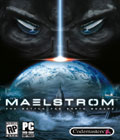Genre: Real-Time Strategy
Publisher: Codemasters
Developer: KDV Games
Release Date: February 20, 2007
Developed by Russian company KDV Games (formerly K-D Lab), Maelstrom is a strategy-action title set in a post-apocalyptic world. The Earth has suffered a terrible ecological disaster due to a meteor storm that's been dubbed the "Maelstrom." In the aftermath of that catastrophic event, three factions are vying for control of the planet. The Remnants are a group of human freedom fighters who have banded together in order to survive, the Ascension is a global corporation led by an aristocratic family that hopes to control the world and rebuild it in their fashion, and the Hai-Genti is an alien race that has traveled to Earth to seek new resources for its continued existence.
The single-player missions are very story-driven, and they focus on cinematic gameplay with frequent cut scenes using in-game animation. The campaign story was written by James Swallow, who has written screenplays for "Star Trek: Voyager" and "Doctor Who."
Maelstrom takes elements from a number of other games and combines them. It incorporates hero units that gain levels and abilities as they fight; each race has three unique hero units with varying abilities. Normal units also gain experience as they fight, and they will increase in health and attack power as their rank increases. For the most part, the game plays in normal RTS fashion: You construct a base, build units, and fight the enemy for map control. Many of the units have special abilities that must be activated, so micromanagement plays a role in winning the battles. The maximum unit selection count is 12, similar to Starcraft and Warcraft III.
You can also take direct control of your heroes, which is a new and interesting twist. When you assume control of a hero unit, you switch to a third-person view of the character, with the camera positioned directly behind him/her. In this mode, you control your character in a first-person shooter fashion; you move your hero with the WASD keys, and you control the targeting reticle and fire your weapon with the mouse.
Maelstrom incorporates three resource types: power, water, and salvage. The two human factions, the Remnant and the Ascension, utilize all three resource types, while the alien Hai-Genti use only water and bio-matter, which are harvested from salvage heaps and dead corpses. Many of the features people have come to expect from RTS games have been incorporated as well, such as way points, action queues, and control groups. However, in the preview build that I played, the game did not use hot keys for unit abilities.
Water plays a key role in many of the maps, as many of them have rivers and lakes that block off areas. The human factions must upgrade their vehicles in order to safely cross the water, but the Hai-Genti units are naturally aquatic, which gives them an advantage when dealing with amphibious operations.
A lot of consideration has been given to properly balancing the game so that no one faction is stronger than the other. Led by former U.S. Navy Officer James Buchanan, the Remnants are a group of resistance fighters consisting mostly of brigands, former military personnel, and ordinary citizens that survived the Maelstrom. In their fight against the oppressive nature of corporations like the Ascension, they rely on adaptability, cunning, and guerilla warfare to achieve victory.
Their equipment is mostly scavenged from enemies and the remains of civilization, and many units are makeshift and pieced together from parts. The Remnant units represent a middle ground between quantity and quality, and they employ a variety of infantry. The trooper is the basic unit and comes equipped with an assault rifle, the bull's-eye is a sniper that can be temporarily cloaked, the firebug carries an anti-infantry flamethrower, and the marauder carries a machine gun and is capable of launching incendiary grenades.
The Ascension is a powerful corporation that specialized in military research before the Maelstrom, and they now strive to restore Earth and create a Utopian society. However, this involves eliminating everyone who doesn't agree with them or stands in their way. All Ascension buildings have solar panels and produce a small amount of power so the Ascension have no need for dedicated power plants like the Remnants. For the most part, the Ascension has powerful but expensive units, which leads to an emphasis on quality over quantity.
The Ascension uses mobile construction vehicles known as Vanguards, which have the ability to morph into buildings, transform back into vehicles, and relocate themselves elsewhere. They are capable of changing into a variety of building models, which allows the Ascension to have highly mobile bases that can move to other parts of the map. Many of the Ascension units have the ability to transform into something else, such as the Viper, which can turn into a turret, and the Crusader tank, which can morph into a bipedal mech unit.
The Hai-Genti is an alien race originating from a distant star system known as Proxima Centauri. A devastating civil war has destroyed the ecosystem on their home planet, and they now need to occupy a new planet in order to survive. Earth just happens to be that planet. The Hai-Genti use bio-engineered technology to create buildings and warriors, and they are ruled by an overmind-like being known as "The Overseer." The Hai-Genti doesn't use the power resource like the human factions, so they are only concerned with water and salvage. The salvage spots are where they build bio-mass farms for gathering, and the areas around water pumps can be flooded with a bio-mixture that hurts enemy units but heals Hai-Genti units.
The Hai-Genti units are relatively cheap, and they rely on large quantities of troops to win battles. Because of this, they can – and need to – produce troops the quickest. Many of the Hai-Genti units focus on melee damage. The spawn, which is the basic unit, is fast and lightly armored; the devourer is heavily armored and formidable against light vehicles; the crusher, which is a giant beetle-like creature, can easily destroy heavy vehicles.
The graphics take a different approach than most RTS games by using a voxel-based system, as opposed to textures mapped onto polygons. This approach makes objects look less blocky in nature than polygonal graphics, and it allows them to look more natural rather than contrived. This technique was also used in Command and Conquer: Tiberian Sun and Command and Conquer: Red Alert 2 to render some of the vehicles. The game incorporates a greatly enhanced version of the engine that was used in the 2004 real-time strategy title Perimeter, and it also incorporates fully rotating camera angles with a wide zoom range.
The terrain in Maelstrom is highly deformable; explosions will create craters and take sections out of hills, and construction units can raise, lower, or flatten terrain. This can be helpful in base defense by allowing the player to make dirt walls to protect areas.
Although the multiplayer mode was not included in the preview build that I played, it is planned for the retail version of the game. Maelstrom will also include a battle mode for quick skirmish missions against the computer and a campaign mode.
Maelstrom provides a new and interesting blend of diverse gameplay types, while remaining a real-time strategy at the core. Look for it soon as it hits store shelves in late February 2007.
More articles about Maelstrom: The Battle for Earth Begins










 Maelstrom is a strategy action epic which takes place on a devastated future Earth. In the wake of an apocalyptic ecological disaster, the planet is threatened by an alien invasion, thus becoming the battleground as a divided human race fights for survival.
Maelstrom is a strategy action epic which takes place on a devastated future Earth. In the wake of an apocalyptic ecological disaster, the planet is threatened by an alien invasion, thus becoming the battleground as a divided human race fights for survival.










































